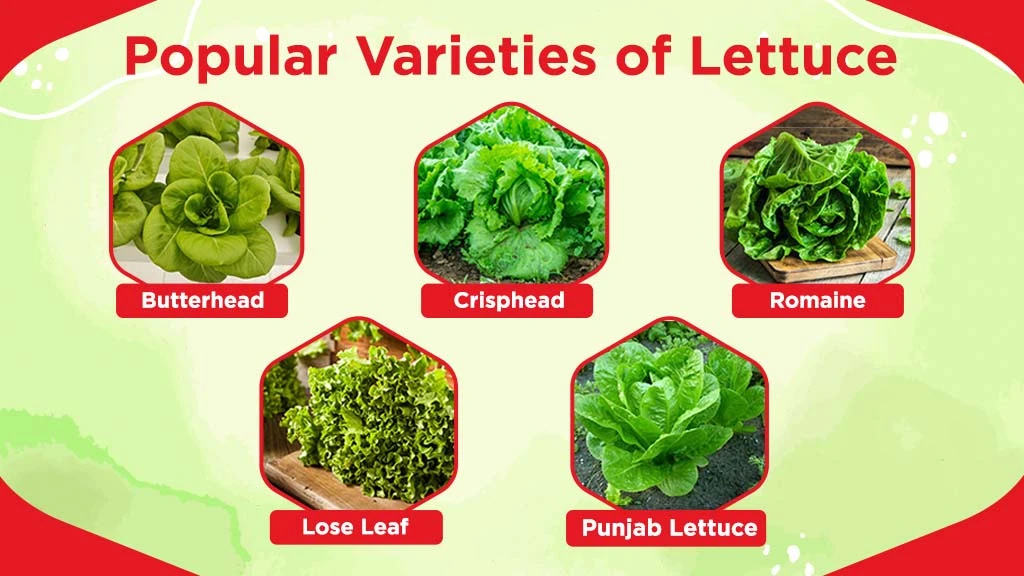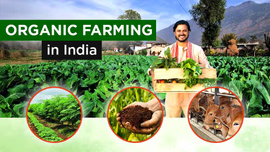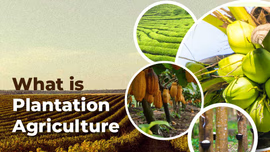Lettuce Cultivation in India: From Sowing to Harvest

Table of Content
- Introduction to Lettuce Farming
- Different Varieties of Lettuce
- Important Steps to Lettuce Farming
- Why is Lettuce Farming Popular in India?
Introduction to Lettuce Farming
Lactuca sativa, commonly referred to as lettuce, is a member of the daisy family (Asteraceae). It is one of the most popular green salads in the world. This verdant, green vegetable is known for its many health benefits as it is packed with nutrients and antioxidants. The vegetable contains high amounts of vitamin A, B, C, and K and other nutrients such as folate, dietary fibre, calcium and iron.
India is the third-largest commercial lettuce producer in the world. The Nilgiri regions in the South and state of Tamil Nadu are some of the highest Lettuce producing states in India. India is also home to native lettuce species called Lactuca indica (Indian lettuce), grown in the regions of Meghalaya and Sikkim.
Different Varieties of Lettuce

|
Lettuce Type |
Key Features |
Harvesting Time |
|
Butterhead |
Loose, soft head with tender, buttery textured leaves; Mild flavor. |
45-55 days |
|
Crisphead (Iceberg) |
Densely packed crunch heads; Mild flavor, high water content. |
70-100 days |
|
Romaine |
Upright, Elongated head; Crisp texture, slightly sweet taste. |
75-85 days |
|
Lose Leaf |
Fast growing, Tender, Varied colors and shapes. |
45-55 days |
|
Punjab Lettuce |
Non-heading type, Crispy, Shiny leaves; Light green color. |
45-50 days |
Important Steps for Successful Lettuce Farming
Here are some important steps for successful lettuce cultivation and farming.
Soil & Climate
Lettuce grows best on sandy loam and fertile soil that should be rich in organic matter. If the soil is too acidic or alkaline, it can negatively affect plant growth and nutrient absorption. The pH level of the soil should be kept between 6.0-6.8. Ensure proper drainage to avoid waterlogging. Lettuce is primarily grown in regions with moderate winters and cool summers. These plants grow best in cool and mild climates where the temperature should be between 10 - 20°C.
Land Preparation
Prepare the land by ploughing the field twice or three times to achieve a fine tilth. This helps improve soil aeration. Lettuce has sensitive roots that are more susceptible to drying. For this reason, it is important to provide sufficient water and adequate drainage. Incorporate organic manure by adding compost or well-rotted manure into the soil a few weeks before planting, which helps increase fertility.
Seed Rate & Sowing
Lettuce is grown through the open field method using 0.5-1 kg of seeds per hectare. When sowing in trays or beds in nursery, it is suggested that the amount of seeds for vegetables to be used is 200-300 grammes of seed per hectare.
After four to six weeks of the first stage, these seedlings are taken to the main field to grow. In direct sowing, the planting depth is 0.5-1 cm. The rows must be a distance of 30-45 cm, and the plants should be separated by 20-30 cm.
Seeds grow quickly in 3-4 days. Lettuce needs to receive sunlight for at least 3-4 hours each day shortly after germination.
Sowing of lettuce is between the months of September and November, however, in the hilly areas it is sown between March and June
Irrigation & Intercultural Operation
Provide the plants with adequate water before and after transplanting. Irrigation of nursery beds should be stopped 48 hours before transplantation. Irrigate the plants properly only 30 minutes before transplanting. Provide the first irrigation right after transplanting.
Irrigate at a 5–6-day interval on light soils and an 8–10-day interval on heavy soils. Frequent and light irrigation is more beneficial in lettuce cultivation for increasing productivity and quality. Daily irrigation is advised in regions with minimal rainfall. When watering, keep the water towards the plant's base to avoid watering over the leaves.
During lettuce cultivation, regular intercultural activities such as weeding, shallow hoeing, and mulching are also important in order to grow healthy plants. Shallow hoeing and weeding should be carried out every 15-21 days. Mulching is another useful way for protecting roots from soil erosion and promoting plant growth by raising soil temperatures throughout the winter. It also helps to keep leaves from decaying.
Fertiliser Management & Manuring
Fertiliser management and manuring are important steps in the process of lettuce cultivation, as they provide the plant with the proper nutrients at the appropriate time.
Start by adding phosphorus and potassium to the soil (before transplanting), around 40-50 kg per hectare of each if the soil test indicates a low level. To encourage root growth, add a granular NPK fertiliser in the ratio of 12:24:12 to each plant at a rate of 5 gm (1 teaspoon). After 7-14-21 days of transplanting, apply a granular NPK fertiliser, at a ratio of 20:10:10, to each plant at a rate of 5-15 gm (1-3 tablespoons), depending on the plant's condition. If you prefer a foliar fertiliser, mix 5 gm (1 teaspoon) of the fertiliser with 4 litres (1 gallon) of water and apply 125 ml (1/2 cup) of this mixture to each plant's leaves and roots once a week.
To prevent tip burn, ensure adequate calcium by adding calcium nitrate and maintain consistent soil moisture.
Pest & Disease Control
Effective pest & disease control in lettuce cultivation is extremely important in order to protect plants and produce a healthy yield. This can be done through an integrated approach of combining cultural practices, biological control, and necessary chemical intervention.
Pests: Common pests such as aphids, caterpillars, and thrips can be removed manually using neem oil or insecticidal soap. Introduce natural-predatory insects like ladybugs and parasitic wasps. For caterpillars, Bacillus thuringiensis (BT) works well, and slugs can be managed with diatomaceous earth powder or copper barriers.
Plant Diseases: Some of the most common diseases seen in plants include downy mildew, fusarium, verticillium wilt, and mosaic virus. These diseases can be readily avoided by using disease-resistant seed varieties, ensuring sufficient drainage for plants, and avoiding overhead irrigation. Crop rotation and adequate spacing, together with keeping the field clean, can help reduce pathogen growth.
Harvesting
Harvesting lettuce typically starts as soon as the plants reach a suitable size and firmness. The variety of lettuce and the purpose of cultivation determine the stage of harvest maturity. Leafy varieties are usually available for harvesting in 50-70 days once their leaves have fully developed to a tender state. Head-type varieties, on the other hand, take longer to grow, typically 70-80 days. The harvesting period varies depending on the season of cultivation. Lettuce grown in the summer season can be harvested in 50-60 days, and winter-grown lettuce takes around 120 days. Harvesting can be done by hand or by cutting the plant just above the soil surface.
Post Harvesting
To preserve the quality of lettuce and extend its shelf life, it is necessary to cool it immediately following harvest. After harvesting, sift and grade the leaves based on head size, leaf size, and so on. Following that, lettuce is packed into crates or cartons. The best temperature for storing lettuce is between 0 - 20°C, with a relative humidity of more than 95%. This will help to maintain the lettuce's freshness for 2-3 weeks.
Why is Lettuce Farming Popular in India?
Lettuce farming has seen a substantial rise in popularity among Indian farmers in recent years, owing to its rising demand among in food industry and due to promising economic returns. While urbanisation and health-conscious trends have driven up demand for this nutrient-dense vegetable, it has also become an economically viable option for farmers. Lettuce cultivation today represents profitable opportunity for Indian farmers.


Related Blogs












